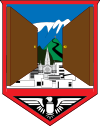Manizales
| Manizales | |||
|---|---|---|---|
| — City — | |||
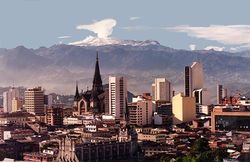 |
|||
|
|||
| Motto: The city of open doors - World Capital of Coffee | |||
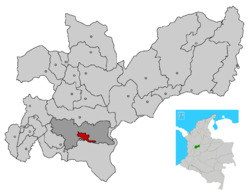 |
|||
 Manizales
|
|||
| Coordinates: | |||
| Country | |||
| Region | Andean Region | ||
| Department | Department of Caldas | ||
| Foundation | October 12, 1849 | ||
| Government | |||
| - Mayor | Juan Manuel Llano Uribe | ||
| Area | |||
| - Total | 508 km2 (196.1 sq mi) | ||
| Elevation | 2,150 m (7,054 ft) | ||
| Population (2005) | |||
| - Total | 414,349 | ||
| - Density | 815.6/km2 (2,112.5/sq mi) | ||
| Time zone | Eastern Time Zone (UTC-05) | ||
| Website | alcaldiamanizales.gov.co |
||
Manizales is a city and municipality in central Colombia, capital of Department of Caldas and part of the region of Colombian Coffee-Growers Axis, near the Nevado del Ruiz volcano.
Nowadays the city is the main center for the production of Colombian coffee and an important hub for higher educational institutions.
Contents |
Geography
Manizales is the capital city of one of the smallest Colombian departments. The city is described as having "abrupt topography"; it is built in a mountain region with a number of ridgelines and steep slopes. Combined with the seismic instability of the area, this has required architectural adaptations and public works to make the city safer. Even though Manizales has a very difficult topography, there are a lot of coffee plantations in these fertile lands. The city is located in the north of the Colombian Coffee-Growers Axis ("Eje Cafetero"), near the volcano Nevado del Ruiz, which has an altitude of about 5.321 meters.
History
Manizales was founded October 12, 1849, in the middle of a civil war between bipartisan followers; Liberals against Conservatives. The city was founded by a group of twenty Antioquians (The Expedition of the 20), which came from Neira and Salamina. There is a strong Spanish influence in the culture and the population was very homogeneous, mostly whites, until other races and ethnic groups migrated to the city in search of the outstanding universities. A big deal of tango is enjoyed in the city and there is a new appetite for jazz.
Hydrography
Basin of the Rio Chinchiná and sub basin of the Guacaica River.
Natural threats
Earthquakes, mud slides, and volcanic eruptions
Culture
The most important cultural events held are the International Festival of Theater City of Manizales, which is one of the major theater events in Latin-America, the Manizales Jazz Festival which gather Jazz Musicians from all over the world, it's held annually.
The Manizales Fair was born in 1951 with the first centenary of the city. It began with the presentation of grand Bullfights and with typical "Manolas" parade (Spanish parade). Due to its huge welcome by people, more shows and presentations have been brought into the Fair, such as International Coffee Beauty Pageant which together with the bullfighting season turn into the main events of the Fair.
Currently within the Fair you can enjoy activities as: Horseback riding Parades, Typical presentations, "Trovas", other parades, National and International Musicians and Bands, Expositions, and Cultural shows. The Feria de Manizales (Manizales Fair) is the second biggest celebration in the country, after the Barranquilla Carnival.
Museums
- Gold museum of the Banco de la Republica
- Museum of Natural History Universidad de Caldas
- Museum of Art Universidad de Caldas
- Archaeological Museum Universidad de Caldas
- Botanical Garden Universidad de Caldas
- Natural Museum of Histories CC
- Museum of Science and the Game Universidad Nacional de Colombia
Periodic Events
- Annual Fair of Manizales (Feria de Manizales) [January]
- Bullfighting Season of Manizales [January]
- International Coffee Beauty Pageant [January]
- Image Festival [April]
- International Theater Festival [September/October]
- Manizales Jazz Festival [September/October]
Education
Manizales is an important regional cultural and educational center. It has the most universities per capita of any city in Colombia. The city has a student population of some 30,000 people that attend 6 colleges and universities:
- Universidad Nacional de Colombia
- Universidad de Manizales
- Universidad Autónoma de Manizales
- Universidad Católica de Manizales
- Universidad Luis Amigó
- Universidad de Caldas
Economy
Manizales' economy is based on coffee production and processing, steel and other metal manufactures, car parts manufacturing, food industry and educational services. In the last ten years Manizales has developed facilities and trained personeel for contact centers, that made important companies from Spain like Emergia and Digitex to move business units to this city, creating over 8000 working positions.
Transportation
- La Nubia Airport
- Travel around by bus costs approximately 900 COP to 1300 COP (between 40 and 90 cents US). To get around by taxi is quite cheap: a minimum fee of 2,900 COP (about 1.50 dollar US). Travel by bus to nearby cities is also fairly cheap; for example a bus ride to Medellin, a city 4 or 5 hours away, costs 32,000 COP one way (about $15 US).
Sports and Entertainment
The city is also known as the home of the football club Once Caldas, the winner of the 2004 Libertadores Cup, South America's main club competition.
Tourist Sites

- Neo-Gothic Cathedral, made by an Italian architect - rare in Colombia
- Nevado del Ruiz Natural Park (with caves and snow)
- Thoughts Recinct Park (El Recinto del Pensamiento)
- Los Yarumos Ecological Park
- Ruiz Hot Springs ("Thermal Waters")
- Otún Hot Springs ("Thermal Waters")
- La Rochela
- Santágueda
- Simon Bolivar Park
- (Francisco Jose de) Caldas Park
- Rustic Club
- Manizales Club
- Route of Nereidas
- Route to Neira
- Route of Rioclaro
- Route of Chinchiná
- Route of La Cabaña
- Murillo Route
- Route of "Cerro Bravo"
- Paramo Cocteles
Sister cities
 Rosario, Argentina
Rosario, Argentina Montreal, Canada
Montreal, Canada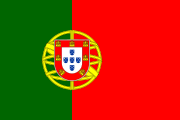 Lisbon, Portugal
Lisbon, Portugal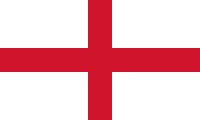 Oxford, England
Oxford, England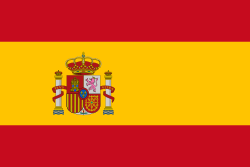 Barcelona, Spain
Barcelona, Spain Valencia, Spain
Valencia, Spain
See also
- 1999 Armenia earthquake
Photo gallery
External links
- (English) Manizales Info Page
- (Spanish) Manizales promotional video
- (Spanish) - Album fotográfico de Manizales
- (Spanish) Comunidad de Manizales
- (Spanish) La Patria - Local newspaper
- (Spanish) - Manizales Video
- (Spanish) - PARAMO, one of the best coffee Bar in Manizales
- (Spanish) Manizales Live TV channel on Internet
- (Spanish) Manizalitas.com Red social de la ciudad de manizales
|
|||||||

